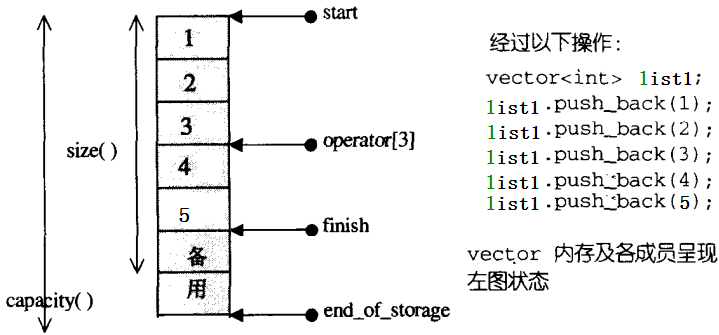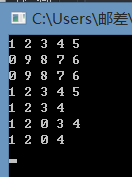STL源码初步接触
STL = Standard Template Library,直译过来是:标准模板库,是惠普实验室开发的一系列软件的统称。从根本上说,STL是一些“容器”的集合,这些“容器”有list,vector,set,map等,STL也是算法和其他一些组件的集合。这里的“容器”和算法的集合指的是世界上很多聪明人很多年的杰作。STL的目的是标准化组件,这样就不用重新开发,可以使用现成的组件。STL现在是C++的一部分,因此不用额外安装什么。STL所实现的,是依据泛型思维架设起来的一个概念结构。说了这么多还是不知道STL是个什么东东,今天只是初接触这个概念,感觉很高深的样子,先这样理解吧,STL就是一个仓库,一个存放各种工具的仓库。它的工具分为六大类(六大组件) :
容器(containers):各种数据结构,如Vector,list,deque,set,map,用来存放底层数据。一般有序列式(下面要写的Vector就是个这种)、关联式等。
算法(algorithms):各种常用算法如:sort,search,copy,erase……
迭代器(iterator):扮演容器与算法之间的胶合剂,是所谓的“泛型指针”,共5种类型,以及他们的衍生变化。所有的STL容器都附带有自己专属的迭代器。原生指针也是一种迭代器。
仿函数(functor):行为类似函数可作为算法的某种策略。一般函数指针可认为是侠义的仿函数。
配接器(adapter):一种用来修饰容器,或仿函数,或迭代器接口的东西。
配置器(allocators)负责空间配置与管理。配置器是一个实现了动态空间配置、空间管理、空间释放的class template。
因为下面主要是实现Vector的简单操作,所以就再多讲一点它。Vector是动态空间,随着元素的加入,它的内部机制会自行扩充空间以容纳新元素。因此Vector的运用对于内存的合理运用与运用得灵活性有很大的帮助。Vector维护的是一个连续的空间,无论元素的型别为何,普通指针都可以作为Vector的迭代器而满足所有必要条件。
Vector 的简单实现:
1 #pragma once
2 #include<iostream>
3 #include<assert.h>
4 #include<stdlib.h>
5 using namespace std;
6 template<class T>
7 class Vector
8 {
9 public:
10 typedef T* Iterator;
11 typedef const T* Citerator;
12 public:
13 Vector()
14 :start(NULL)
15 ,finish(NULL)
16 ,endofstorage(NULL)
17 {}
18 Vector(const Vector<T>& v)
19 //:start(new T[v.endofstorage - v.start])
20 //, finish(v.finish )
21 //, endofstorage(v.endofstorage)
22 :start(new T[v.endofstorage - v.start])
23 , finish(start + (v.finish - v.start))
24 ,endofstorage(start + (v.endofstorage - v.start)) {
25 my_memcopy(start, v.start, sizeof(T)*(v.endofstorage - v.start));
26 }
27 //向Vector中存入size个元素
28 Vector(Citerator array, size_t size)
29 :start(new T[size])
30 , finish(start)
31 , endofstorage(start + size) {
32 for (size_t index = 0; index < size; ++size) {
33 start[index] = array[index];
finish++;
34 }
35 }
36 Vector<T>&operator=(const Vector<T>& v) {
37 if (this != &v) {
38 Vector<int>tmp(v);
39 swap(tmp);
40 }
41 return *this;
42 }
43 ~Vector(){
44 if (start) {
45 delete[] start;
46 start = NULL;
47 // delete[] finish;
48 finish = NULL;
49 // delete[] endofstorage;
50 endofstorage = NULL;
51 }
52 }
53 // 返回首元素的迭代器
54 Iterator Begin() {
55 return start;
56 }
57 Citerator Begin()const {
58 return start;
59 }
60 // 获取Vector中最后一个元素的下一个位置
61 Iterator End() {
62 return finish:
63 }
64 Iterator End()const {
65 return finish;
66 }
67 size_t Size()const {
68 return finish - start;
69 }
70 size_t Capacity()const {
71 return endofstorage - start;
72 }
73 bool Empty()const {
74 return finish == start;
75 }
76 T& operator[](size_t index) {
77 return start[index];
78 }
79 const T& operator[](size_t index)const {
80 return start[index];
81 }
82 T& At(size_t index) {
83 if ((index <= Size()) && (index >= 0))
84 return start[index];
85 }
86 const T& At(size_t index)const {
87 if ((index <= Size()) && (index >= 0))
88 return start[index];
89 }
90 // 获取Vector中的第一个元素
91 T& Front() {
92 return srart[0];
93 }
94 const T& Front()const {
95 return start[0];
96 }
97 // 获取Vector中的最后一个元素
98 T& Back() {
99 return start[finish - start];
100 }
101 const T& Back()const {
102 return start[finish - start];
103 }
104 void PushBack(const T& x) {
105 capacity();
106 // start[finish - start + 1] = x;
107 start[finish - start] = x;
108 finish++;
109 }
110 void PopBack() {
111 if (!Empty()) {
112 finish--;
113 }
114 }
115 // 在pos位置上插入元素x
116 Iterator Insert(Iterator pos, const T& x) {
117 for (size_t index = Size(); index >= (size_t)(pos - start); index--) {
118 start[index + 1] = start[index];
119 }
120 *pos = x;
121 finish++;
122 return pos;
123 }
124 // 删除pos位置上面的元素
125 Iterator Erase(Iterator pos) {
126 for (size_t index = (size_t)(pos - start); index < Size(); index++) {
127 start[index] = start[index + 1];
128 }
129 finish--;
130 return pos;
131 }
132 // 给Vector赋值n个值为x的元素
133 void Assign(size_t n, const T& x) {
134 if (n > endofstorage - start) {
135 finish = start + n;
136 capacity();
137 for (size_t index = 0; index < n; index++) {
138 start[index] = x;
139 }
140 }
141 else {
142 for (size_t index = 0; index < n; index++)
143 start[index] = x;
144 }
145 finish = start + n;
146 }
147 public:
//自己管理 扩容
148 void capacity() {
149 if (finish >= endofstorage) {
150 size_t capacity = 2 * (endofstorage - start) + 3;
151 Iterator tmp = new T[capacity];
// 拷贝元素
152 my_memcopy(tmp, start, sizeof(T)*(endofstorage - start));
154 size_t ret = finish-start;
155 delete start;
156 start = tmp;
157 finish = start + ret;
158 endofstorage = start + capacity;
//
/*Iterator pos = start;
size_t index = 0;
while (pos < endofstprage)
temp[index++] = *pos++;
deleta[] start;
start = temp;
finish = start + index;
endofstorage = start + capacity;*/
159 }
160 }
161 void swap(Vector<T>& v) {
162 std::swap(start, v.start);
163 std::swap(finish, v.finish);
164 std::swap(endofstorage, v.endofstorage);
165 }
166 void Print() {
167 for (size_t i = 0; i < Size(); i++)
168 {
169 cout << start[i] << " ";
170 }
171 cout << endl;
172 }
173 void* my_memcopy(void* dest, const void* src, size_t sz) {
174 //assert(!dest || !src);
175 assert(dest != NULL || src != NULL);
176 char* ret = (char*)dest;
177 char* tmp = (char*)src;
178 while (sz--) {
179 *ret = *tmp;
180 ret++;
181 tmp++;
182 }
183 return dest;
184 }
185 private:
186 Iterator start;
187 Iterator finish;
188 Iterator endofstorage;
189 };
之中,注释掉的代码部分是我曾经踩过的坑,下面是部分测试代码
1 #include"vector.h"
2 void Test1()
3 {
4 Vector<int> list1;
5 list1.PushBack(1);
6 list1.PushBack(2);
7 list1.PushBack(3);
8 list1.PushBack(4);
9 list1.PushBack(5);
10 list1.Print();
11 Vector<int> list2;
12 list2.PushBack(0);
13 list2.PushBack(9);
14 list2.PushBack(8);
15 list2.PushBack(7);
16 list2.PushBack(6);
17 list2.Print();
18 list1 = list2;
19 list1.Print();
20 }
21 void Test2()
22 {
23 Vector<int> list1;
24 list1.PushBack(1);
25 list1.PushBack(2);
26 list1.PushBack(3);
27 list1.PushBack(4);
28 list1.PushBack(5);
29 list1.Print();
30 list1.PopBack();
31 list1.Print();
32 list1.Insert(&list1.At(2), 0);
33 list1.Print();
34 list1.Erase(&list1.At(3));
35 list1.Print();
36 }
37 int main()
38 {
39 Test1();
40 Test2();
41 getchar();
42 return 0;
43 }

注意:扩容时函数中my_memcpy()函数,它的本质就是值拷贝,当Vector中存放的内置类型时没有任何问题,但是像String类这种问题就无法解决。所以下面给出了另一种写法。
/*Iterator pos = start;
size_t index = 0;
while (pos < endofstprage)
temp[index++] = *pos++;
deleta[] start;
start = temp;
finish = start + index;
endofstorage = start + capacity;*/
